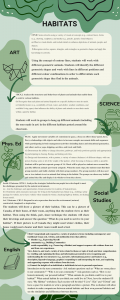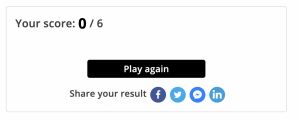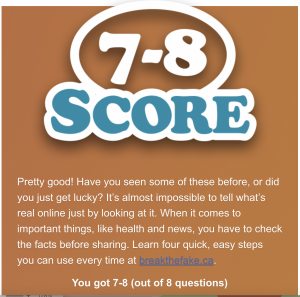Our challenge was to make an infographic that we could present in a split-grade classroom.
Arts Education Grade 3
CP3.8 Create artworks using a variety of visual art concepts (e.g., contour lines), forms (e.g., drawing, sculpture), and media (e.g., pencils, pastels, found objects).
a) Observe visual details, and include details to enhance depictions of animals, people, and objects.
f) Recognize circles, squares, triangles, and rectangles as geometric shapes and apply this knowledge to artwork.
Using the concept of contour lines, students will work with different geometric animals. Students will identify the different geometric shapes and work with lines in different positions and different colour combinations in order to differentiate each geometric shape they find in the animals.
Science Grade 4
HC4.2: Analyze the structures and behaviours of plants and animals that enable them to exist in various habitats.
(b) Recognize that each plant and animal depends on a specific habitat to meet its needs.
(c) Identify factors (e.g., availability of food, water, and shelter, weather conditions, and available living space) that influence the ability of plants and animals to meet their needs within a specific habitat.
Students will work in groups to hang up different animals (including the ones made in art) in the different habitats posted around the classroom.
Physical Education Grade 3
PE3.6: Apply movement variables of:
- extensions in space,
- a focus on effort (time/ speed, force, flow),
- relationships with objects and others
to increase complex movement skills and sequences while participating in body management activities (including dance and educational gymnastics, and others such as yoga, skipping, aerobics, and track and field).
(d) Demonstrate the ability to change directions, pathways, and body positions quickly and appropriately by participating in chasing, fleeing, and deking activities.
(h) Design and demonstrate, with a partner, a variety of statues (balances) of different shapes, with one person bearing some or all of the weight of the partner, while focusing on being as stable as possible.
Students will be put into separate groups of 3-4. Music will be played as students move around the gym like different animals (previously assigned). When the music stops, the students must find their group members and build a habitat with their group members. The group members will also need one or two students to act as animals that belong in the habitat. The groups can choose any habitat and animal they like and display it in whichever form they choose.
Social Studies Grade 4
RW4.1– Analyze the strategies Saskatchewan people have developed to meet the challenges presented by the natural environment.
(a) – List the challenges and opportunities climate presents for residents of Saskatchewan.
(b)- Determine safety measures necessary for living in the Saskatchewan climate (e.g., clothing; safety package for vehicle; never leave vehicle when stranded in winter; checking highway hotline; not licking frozen metal).
Art 3 Outcome- CR3.2- Respond to arts expressions that use the environment (natural, constructed, imagined) as inspiration.
The students will draw a picture of their habitat. This can be a picture of Canada, of their home, of their room, or anything that the student views as their habitat. Then using the think, pair, share technique the students will share their drawings and answer the question “What do you need to survive in your habitat”. If their picture is of Canada they might need winter clothes, their house would need a heater and their room would need a bed.
English Language Arts Grade 4
CR4.1 Comprehend and respond to a variety of grade-level texts (including contemporary and traditional visual, oral, written, and multimedia texts) that address:
- identity (e.g., Expressing Myself)
- community (e.g., Building Community)
- social responsibility (e.g., Preserving a Habitat) and support response with evidence from text and from own experiences.
View, listen to, and read a variety of texts related to theme or topic of study and show comprehension by:
- retelling and explaining the ideas and information presented in texts
- recognizing and understanding the text structures (e.g., narrative, informational, poetry) and features (e.g., description, figurative language, graphics)
- responding to and interpreting the texts, and explaining and supporting response with evidence from the texts.
(c) Connect the insights of an individual or individuals in texts to personal experiences.
Introduction to the term community- Ask students questions such as “What are some places in our community?” “Who is in your community?” Ask questions such as “How is our home/community our personal habitat?” “What animals do you think could live in your habitat?” What animal habitat do you think you could live in? Next, have the students fill out a “My Habitat” worksheet. Each section will be titled “I Live” I Eat” and “I Drink” and have a space for students to write a paragraph and draw a picture. This worksheet will allow students to make comparisons between animal habitats and their own personal habitats and see the similarities and differences between the two.

Our infographic! It’s extremely blurry, so please find the information above!




